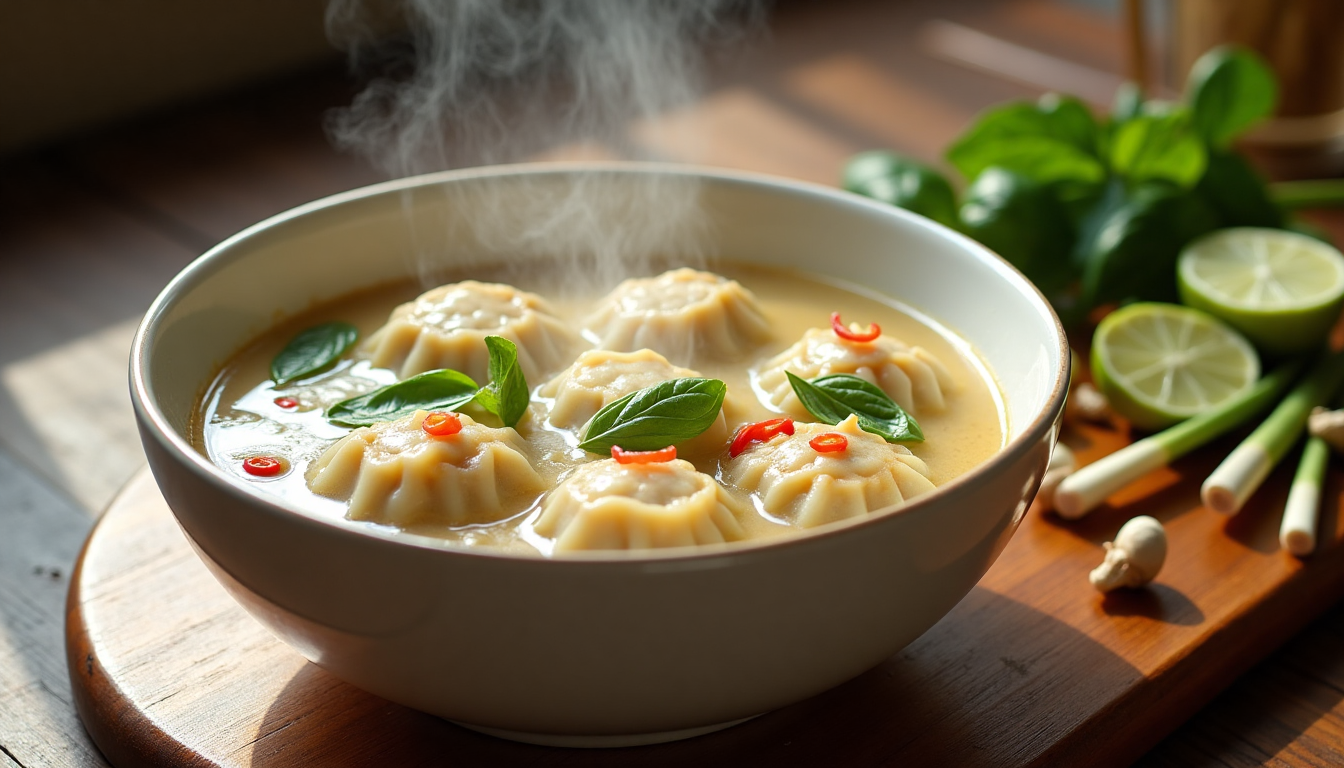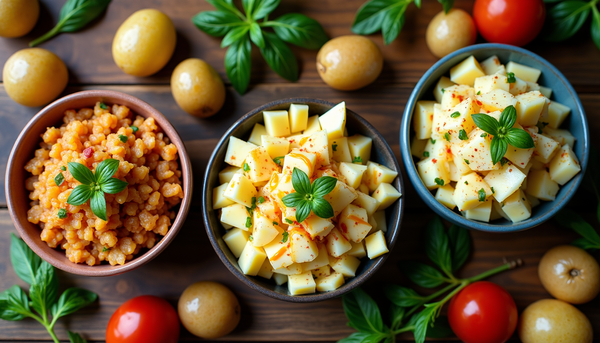The Dumpling Soup That Taught Me About Culinary Identity

You know that moment when you're staring into your freezer at 7 PM on a Tuesday, wondering how frozen dumplings and random vegetables can possibly become dinner? Yeah, I've been there. A lot.
But here's the thing nobody tells you about fusion cooking—sometimes the most "inauthentic" combinations create the most authentic flavors. This ginger coconut potsticker soup became my accidental love letter to growing up between cultures, where Thai curry paste lived next to Chinese soy sauce in our pantry, and nobody questioned it.
Why This Soup Hits Different
I'll be honest—when I first made this, I was just trying to use up ingredients. Frozen gyoza from Trader Joe's? Check. That can of coconut milk I bought for some Pinterest recipe and never used? Also check. But what happened in that pot was pure magic, and I'm not being dramatic (okay, maybe a little).
The thing about this soup is that it doesn't try to be traditionally anything. It's not Chinese hot pot, it's not Thai tom kha, it's not Japanese ramen. It's something entirely new, and that's exactly why it works.
See, when you combine the earthy umami of shiitake mushrooms with the bright acidity of lime and the creamy richness of coconut milk, you're basically creating a flavor trifecta that your taste buds didn't know they needed. Add ginger and lemongrass? Now we're talking about aromatic compounds that complement each other so perfectly it's almost unfair to other soups.
The Science of Why This Works (Bear With Me)
Okay, food nerd moment incoming. The reason this combination is so addictive has everything to do with how these ingredients play together on a molecular level.
Ginger contains gingerol, which gives it that warming spice. Lemongrass has citronella and limonene—those bright, citrusy notes that wake up your palate. Coconut milk provides fat molecules that carry flavors and create that luxurious mouthfeel. And shiitakes? They're packed with glutamates, which is basically umami in chemical form.
When you sauté the aromatics first (pro tip: always do this), you're releasing essential oils and creating new flavor compounds through the Maillard reaction. That's the fancy term for "making things taste more delicious through heat."
But here's where most people mess up—they add everything at once. Don't do that. Layer your flavors. Build them up. Let each ingredient have its moment.
The Real Talk About Making This Soup
Let's talk about the elephant in the room: frozen dumplings. Some people get all precious about using fresh, handmade everything. And look, I respect that. I really do. But you know what? Sometimes good enough is perfect.
I've made this soup with $15-a-pound artisanal dumplings from the fancy Asian market, and I've made it with the $3.99 bag from Costco. Guess what? Both versions were delicious. The expensive ones didn't make me a better cook or a more authentic person.
The key isn't the price tag—it's understanding how to work with what you've got. Frozen dumplings actually hold up better in soup than fresh ones (they don't fall apart as easily), and they're already seasoned inside, which adds complexity to your broth.
Here's my method, refined through many Tuesday night experiments:
Start with good olive oil—not your fancy finishing oil, but something with flavor. Heat it up and add those sliced shiitakes. Don't crowd the pan. Let them get golden and slightly crispy. This step is non-negotiable because mushrooms need to give up their water and concentrate their flavors.
Then comes the aromatic trio: ginger, garlic, and lemongrass. Fresh ginger is crucial here—powdered stuff won't cut it. You want that bright, almost spicy heat. For lemongrass, I cheat and use the tube paste from the store. Sue me. It's consistent, it doesn't go bad, and it tastes great.
The broth situation is where you can really make this your own. Vegetable broth keeps it vegetarian, but chicken stock adds depth. I've even used leftover ramen broth (don't waste good food, people).
Where Things Get Interesting
Once your base is sorted, this is where the soup becomes yours. The original recipe calls for spinach, but I've thrown in everything from bok choy to leftover roasted vegetables. The rule is simple: hearty vegetables go in early, delicate greens go in at the end.
The coconut milk is where people get nervous. "Will it curdle?" they ask. "Should I temper it?" Here's the truth—if you're not boiling the hell out of it, you'll be fine. Add it toward the end, let it warm through, and stop overthinking.
And that lime juice? Don't skip it. It's not just for brightness—acid actually enhances the perception of other flavors. It's like turning up the volume on everything else in the bowl.
The Cultural Mashup That Makes Sense
People sometimes ask me if this soup is "authentic," and I always laugh. Authentic to what? My Korean-American neighbor who taught me to add kimchi to everything? My college roommate from Thailand who showed me how lemongrass can transform any dish? My own Chinese grandmother who would probably be horrified by this combination but would secretly love how it tastes?
Food evolves. It crosses borders, adapts to new ingredients, and becomes something new. This soup is authentic to my experience, to my kitchen, to the way I learned to cook by throwing things together and seeing what works.
I've served this to friends from all over Asia, and you know what they say? "This is really good. Can I get the recipe?"
Making It Your Own
The beauty of this soup is its flexibility. Vegetarian? Use veggie dumplings and vegetable broth. Gluten-free? Check your dumpling labels and you're set. Want more protein? Throw in some leftover rotisserie chicken or soft-boiled eggs.
I've made versions with:
- Miso paste stirred in at the end (umami bomb)
- Thai bird chilies for heat (start with half of one, seriously)
- Fish sauce instead of salt (just a splash)
- Crispy tofu instead of dumplings
- Whatever vegetables were about to go bad in my crisper drawer
The only real rule is to taste as you go and adjust. Too rich? Add more lime. Not enough depth? More ginger or a splash of soy sauce. Want more heat? Chili crisp is your friend.
The Deeper Lesson Here
Making this soup taught me something important about cooking and identity. We spend so much time worrying about doing things "right" that we forget to ask if they taste good. We get caught up in authenticity debates when we could be creating new traditions.
My version probably doesn't exist in any traditional cuisine, and that's perfectly fine. It exists in my kitchen, in my experience, in the way I learned to cook by combining the flavors I love.
Every time I make this soup, it's slightly different. Sometimes I have fresh scallions, sometimes I don't. Sometimes I remember the lemongrass, sometimes I forget until the end and add extra lime instead. These aren't mistakes—they're variations on a theme.
Your Turn to Experiment
So here's my challenge for you: make this soup, but make it yours. What's in your freezer? What flavors make you happy? What would your grandmother think, and does it matter?
Start with the basic framework—aromatics, broth, dumplings, coconut milk, acid—and then go rogue. Add that half-empty jar of curry paste. Throw in whatever vegetables need using up. Trust your palate.
And when someone asks if your version is "authentic," smile and tell them it's authentic to you. Because that's the only authenticity that really matters in your own kitchen.
The best fusion food doesn't apologize for existing. It celebrates the collision of flavors and cultures and creates something entirely new. This soup is my small rebellion against food purism, my argument for convenience without compromise, my love letter to making it up as you go along.
Now go make some soup. And don't forget the lime.
What's your favorite "inauthentic" combination that just works? I'm always looking for new ways to horrify food purists and delight my taste buds.




